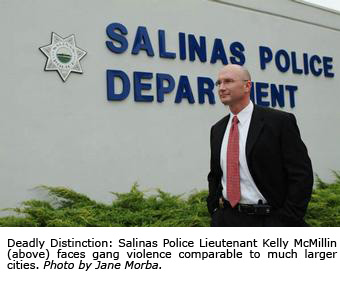 |
 |
||||||||
Gang War Escalates It’s just after 9 o’clock
Saturday night before Salinas Police Sergeant Dave Crabill answers his
cell phone. He’s on duty, with the department’s anti-gang
taskforce, the Violence Suppression Unit. He is wrapped up in yet another
violent weekend on Salinas streets. In just the first half of last weekend, one male, aged 20 to 22, was dead, and one twenty-year-old male and his fourteen-year-old female companion were recovering from gunshot wounds. They were all gang-related. Gang violence in Salinas is as pervasive as in notoriously violent Oakland. It’s not uncommon to read governmental case studies containing lists of communities most plagued by gangs, those most noteworthy for research, and to see the tiny City of Salinas sandwiched between cities ten times its size: Los Angeles, New York. The violence has reached deeper into the community than those on the outside seem to understand. School shopping has become an issue of kids’ safety: no solid colored red or blue shirts, no Dickies, no Ben Davis. How a kid wears a baseball cap, to one side or the other, can unwittingly speak volumes. Pro football team garb complicates it even further: 49er red and Dallas blue say too much on the streets. How the Oakland Raiders do on any random Sunday can determine safety on Salinas’ streets, as evidenced by riots and gang violence immediately thereafter. Any ten-year-old kid riding in a car home from school with Mom or Dad has to be told not to stare off into oblivion or at other kids too long. That’s considered mad-dogging, or a challenge, and can have devastating effects. It’s an entire generation at risk, and over what exactly is anyone’s guess. Salinas Police Lieutenant Kelly McMillin explains that there are countless organized gangs throughout the city. To date, though, the police department is tracking about two dozen active ones. They’re deeply rooted, having organized in the city in the mid-sixties. “It started when a group of gang members came to Salinas to prey on the farm workers,” McMillin says. “To protect themselves, the farm workers started their own gang.” The struggle for power in Salinas began then. The Nuestra Familia, or Norteños, originated in the north. The Mexican Mafia, or Sureños, came from the south, though dividing lines are just delineated by colors, tattoos, and taggings nowadays. Divisions can become even more nebulous just within immediate families. “You can have two brothers sitting at one dinner table, one claiming the north, the other claiming the south,” McMillin says. The gangmembers’ mutual disdain is deadly. “Every one of our criminal homicides this year has been gang-related,” McMillin says. At press time, that number was at 13. Despite a drop in membership numbers in the late ‘90s—perhaps as a result of an undercover FBI sting known now as Operation Black Widow, when some 22 indictments were handed down to supposed gang bigwigs after multiple plans for mayhem and murder were caught on tape—the numbers are right back up today. One of the undercover officers involved in the sting thinks back on it, pondering the city’s violent past and present. He shrugs, then turns away, appearing almost resigned: “There’s a gang shooting in this city every single day,” he says. Shi Cota would know. She was hanging and banging with gangs most of her teenage life. A recruit at 14, a full-fledged member by 17, Cota was (beat up) by another female and three males. “It was either that or sleep with a bunch of guys to get in,” she says. “And I wasn’t gonna do that.” “A shooting a day? I’d say two or three a day is more like it,” Cota says. “It only makes news if someone’s hurt or killed. Sometimes, not even then.” . . . . . . . . . . . . . . . . . . . . . . . . . . . . . . . . . . . . . . . . . What used to be pockets of gang-infested neighborhoods
has evolved into what can feel like an entire city at risk. Violence
and shootings occur in every part of the city by the roughly 4,000 gang
members who live here. Ultimately, that may have compounded the problem. “It changed our enforcement techniques,” McMillin says. “[Gangs] are mobile, driving around in every part of Salinas.” Cota, who now spends her days working for Second Chance Youth in Salinas, a nonprofit gang prevention and intervention group, sees the change too. “They’re not even dressing like gang members anymore,” she says. “If your kid wears Polo or Guess, it doesn’t mean anything. We see kids from good families, nice homes, nice cars, well-educated parents, kids who are good students, but they’re banging at school. Then they leave school and go to Boy Scouts and church or straight home like a good boy. There is no typical kid anymore.” McMillin says parents are as much to blame as anyone. “Common sense has to prevail,” he says. “If your kid tells you he’s going to a football game, that’s great. But do you know that for sure? Do you know who his friends are? Parents turn a blind eye. We’ve gone into homes and taken parents through their kid’s bedroom and said, ‘Look at what’s up on his wall, on his dresser, in his closet. Your son is a gang member.’ And still, they’re in denial. ‘No, no, not my son.’” The city’s solution, intervention and prevention, takes money, and a lot of it. The city’s police department is understaffed, and consequently so is its Violence Suppression Unit. “But we can’t work backwards,” McMillin says. “We have to take what we’ve got, deal with the gang members who are already involved. But we really have to focus on the kids who can still be helped.” Some of that help came last week in the form of a $150,000 grant from the Department of Health and Human Services. The grant, garnered by Rep. Sam Farr, was awarded to Salinas’ Partners For Peace, a community organization with the mission of reducing gang violence. Headed by Mayor Anna Caballero, the nonprofit intends to use the money for mental health issues as they relate to the city’s violent trends. “This is just one of what we hope will be several grants to help several groups within the city to fight gang violence,” Farr’s office said. “We’re also working to find money for extra cops and extra equipment. In the meantime, we have to nurture the children to think in different ways, give them incentives not to get into gangs to begin with, to start with kids who are at risk of being sucked into the violent arena. It’s easier to prevent than to get them out once they’re in.” Last week, US Sen. Barbara Boxer toured the streets of Salinas for a glimpse into the life of Salinas residents. Boxer is working to secure $3.3 million in federal money to fund a local joint taskforce to combat gang violence. The grant, spearheaded earlier this year by Sheriff Mike Kanalakis, Mayor Anna Caballero, Police Chief Dan Ortega, and County Supervisor Lou Calcagno, would help to create a 17-member team, including the Probation Department, Sheriff’s Department, Salinas Police Department, and the District Attorney’s office. . . . . . . . . . . . . . . . . . . . . . . . . . . . . . . . . . . . . . . . . . Luckily for Cota, she was able to get out. “The
last time I picked up a gun, I was four months pregnant,” she
says. “And I knew I had to stop. I was in trouble, addicted to
drugs, suicidal, and I had a baby on the way. So I went to the people
I had to report to, and I told them, ‘Ya know, I’m having
a baby, and I’ve got to get out.’ They were like, ‘Okay,
you do what you have to do.’” “They didn’t care that I was pregnant. I had a guy jump over the counter at me, had people throw drinks at me. They called me names,” she recalls. The experience of trying to get out may well be what drives her now. “It was all I knew. My dad was a gang member, in and out of prison, and I just figured I should be one too,” she says. As the level of violence continues to escalate, so too does Cota’s motivation. “It’s not about fighting in the streets with chains and knives anymore. It’s firebombs, grenades, guns, whatever. Anyone on the street can get a gun in thirty minutes.” McMillin concurs. “It is so much more violent,” he says. “And that level of violence is completely unacceptable. Our youth are dying. But we can stop it absolutely. And we intend to.” “There just needs to be more awareness,” Cota says. “Parents need to listen to their kids, spend time with them. Take a day off of work and be with them. Check up on them. The kids I see, they don’t come in here wanting to quit gangs. They’re here because the court made them come. But I listen to them, respect them. They just want to be heard. Sometimes no one has done that before. And then, yeah, they leave. But they come back. They always seem to come back.” Articles reprinted courtesy of Monterey
County Weekly |
Bad News for Local Women |
|||
 Asked about stats—murders, attempts, and random shootings—Crabill
struggles briefly with sorting one night of duty, from the next. “Let’s
see,” he thinks out loud. “What day is this?” It isn’t
a rhetorical question, and he waits for an answer. When he hears it
is Saturday, he starts with the gang murder from just past midnight
the night before. Asked how Saturday is going, Crabill sounds disgusted.
“Couple more shootings so far tonight,” he says, “a
few minutes ago.”
Asked about stats—murders, attempts, and random shootings—Crabill
struggles briefly with sorting one night of duty, from the next. “Let’s
see,” he thinks out loud. “What day is this?” It isn’t
a rhetorical question, and he waits for an answer. When he hears it
is Saturday, he starts with the gang murder from just past midnight
the night before. Asked how Saturday is going, Crabill sounds disgusted.
“Couple more shootings so far tonight,” he says, “a
few minutes ago.”